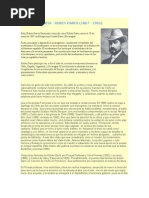Descargar Los Raros De Ruben Dario Pdf To Word

Rubén Darío 1867–1916

Ruben Dario Espanol
(Pseudonym of Félix Rubén García Sarmiento) Nicaraguan poet, short story writer, journalist, critic, essayist, autobiographer, and novelist.
The resurrection of Hispano-American poetry. By Emir Rodriguez Monegal. GREAT MEN, GREAT EVENTS. THE WORLD FOOD. Words: Institut du. Radium, Pavillon. This 'temple of the future' was now ready to receive its radium, its workers and its director. With the outbreak of the First World.
Though not widely known in the English-speaking world, Darío was one of the great Spanish poets and the leading figure of the late nineteenth-century Spanish-American modernista literary movement. Influenced by French Parnassian and Symbolist poetry, he revitalized Spanish poetics, which had essentially remained unchanged since the seventeenth century. A cosmopolitan blend of modernist formal experimentation, classical motifs, and Hispanic traditions, Darío's poetry is valued as much for its linguistic brilliance and technical and formal innovations as for its advocacy of Hispanic solidarity and concern about the universal human condition.
Biographical Information
Born Félix Rubén García Sarmiento on January 18, 1867, in Metapa, Nicaragua, Darío was a precocious writer, who began using his pseudonym at the age of fourteen. Dedicated to travel and literary pursuits, he emigrated in 1886 to Chile, where two years later he inaugurated the modernista movement with the publication of Azul (1888). After diplomatic service on behalf of Chile in Paris and Madrid, Darío arrived in Buenos Aires in 1893 as Colombian consul to Argentina, where he published Prosas profanas y otros poemas (1896). Following the Spanish-American War, Darío travelled throughout Europe as a correspondent for the Buenos Aires newspaper La natión, focusing his writing on more social, political, and contemporary themes. Between 1903 and 1907 Darío served as Nicaraguan consul to France; while in Paris Darío wrote Cantos de vida y esperanza (1905)—widely admired as his finest work—El canto errante (1907), and Poema del otoño y otros poemas (1910). After more than a decade of crisscrossing the Atlantic Ocean for diplomatic or literary purposes, Darío permanently left Europe in 1914 with plans for a North American lecture tour the following year. However, when Darío developed pneumonia in New York City, he returned to Nicaragua, where he died February 6, 1916.
Major Works
Darío's greatest fame derives from three major poetry collections. Azul, recognized as the defining work of the modernista movement, is a collection of prose and verse that represents Darío's interpretation of the artistic principles of the French Parnassian school—restraint, objectivity, precise description—in his native language. With its

Descargar Los Raros De Ruben Dario Pdf To Word Document
exotic themes and simple, direct syntax, Darío's writings in Azul reanimated Spanish literature. In Prosas profanas, a collection of poems influenced by contemporary French Symbolism and marked by exotic aestheticism, Darío aimed for the formal purity of music by experimenting with unconventional but revolutionary metrical forms. Cantos de vida y esperanza reveals a change in Darío's poetic vision, a move away from aesthetic concerns toward political and social themes. The poetry in this collection ranges from meditations on the future of South America to expressions of Hispanic solidarity under the threat of North American imperialism. Other notable collections of Darío's poetry include El canto errante, which expounds his humanist views by addressing fundamental dilemmas of human existence, and Poema del otoño, which attempts to resolve the poet's own religious and metaphysical conflicts in a passionate celebration of both life and death.
Critical Reception
During his lifetime Darío was the toast of Spanish-speaking literati worldwide, and on his death he was mourned with eloquent eulogies extolling the vibrant language and technical virtuosity of his poetic vision. Salomón de la Selva called Darío 'the Spanish Keats,' and Pedro Henríquez Ureña remarked that 'both Spain and Spanish America saw in him their representative poet.' By mid-century, however, Darío's reputation had diminished somewhat among many scholars who suggested that for all its stylistic flair, his poetry sometimes lacked substance. C. M. Bowra found Darío's poetry explicitly derivative in its emulation of contemporary French verse, though Arturo Torres-Rioseco attributed a perceived critical neglect of the poet to a shift in readers' tastes. Other critics have interpreted and evaluated Darío's work on the basis of his biography, his socio-political position, or his place in literary history. Recent scholarship has continued to elaborate these aspects through close textual analysis, which in turn has highlighted other elements in Darío's poetry as diverse as Pythagorean philosophy and duality in his female imagery. As poet Octavio Paz once observed about Darío's literary significance, 'Darío is present in the spirit of contemporary [Spanish] poets. He is the founder.'